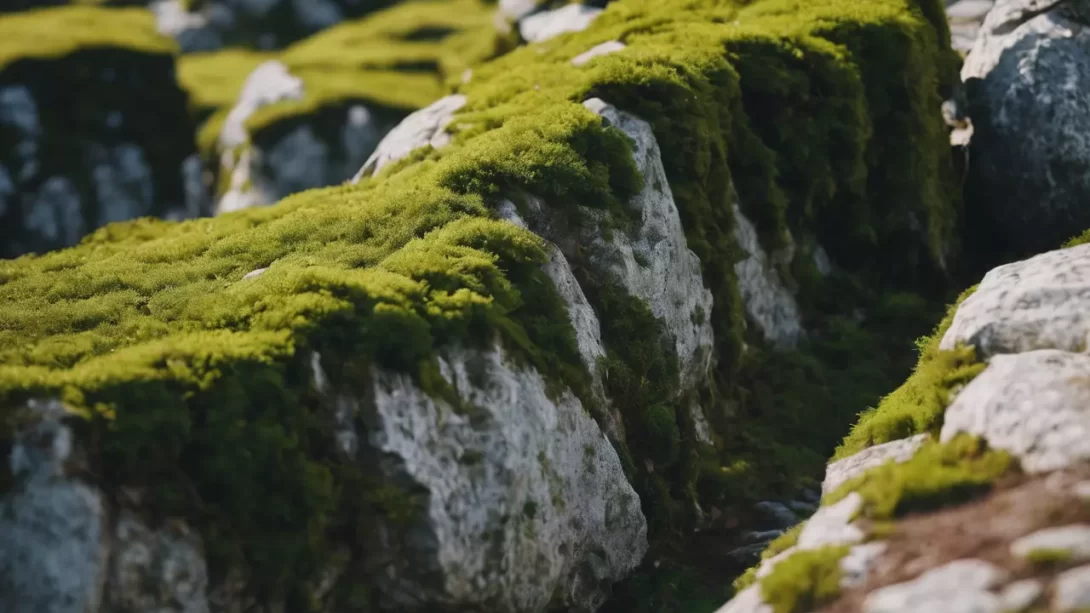Today, we’re delving into a question that intrigues many garden enthusiasts: Does limestone kill moss? This topic is not just a matter of curiosity but a significant aspect of garden maintenance. Moss, with its lush green carpet-like appearance, can be both a desirable and an unwanted guest in our gardens. While some gardeners appreciate its aesthetic and ecological benefits, others find it a nuisance, particularly when it invades lawns and garden beds. Among the various methods proposed for managing moss, the use of limestone stands out. But how effective is it really? Let’s unearth the truth behind this gardening practice and understand whether limestone is a friend or foe in the battle against moss.
Moss
Moss, a simple yet fascinating plant, thrives in environments that many other plants find challenging. Unlike most garden plants, mosses are non-vascular, meaning they don’t have the usual system of roots and leaves for water and nutrient transport. They prefer damp, shady locations and can often be found carpeting the ground in wooded areas or clinging to rocks and tree bark. In our gardens, moss typically appears in areas where the soil is acidic, compacted, poorly drained, or where grass and other plants struggle to survive. While it’s a misconception that moss kills grass or other plants, it certainly can become dominant in areas where conditions favor its growth over others. Understanding these conditions is crucial in effectively managing moss in your garden.
The Role of Limestone in Gardening
Limestone, a common sedimentary rock composed mostly of calcium carbonate, is a staple in many gardeners’ toolkits. Its primary role in the garden is to alter soil pH. Most garden plants thrive in a slightly acidic to neutral pH, but when the soil becomes too acidic, it can limit the availability of essential nutrients. Limestone works by raising the soil pH, making it more alkaline, and thereby improving nutrient availability. It’s particularly beneficial for vegetable gardens, lawns, and flower beds that require a more neutral pH to flourish. In addition to adjusting soil pH, limestone also contributes to improving soil structure and providing essential nutrients like calcium and magnesium. However, its impact extends beyond just altering the soil chemistry; it can also influence the garden’s microecosystem, including the prevalence and growth of moss.
Limestone’s Effect on Moss
Limestone’s impact on moss is primarily indirect, stemming from its ability to alter soil pH. Mosses generally prefer acidic conditions, thriving in a pH range typically below 6.0. When limestone is applied, it raises the soil’s pH level, creating a less favorable environment for moss. However, it’s important to note that limestone doesn’t act as a moss killer in the traditional sense. Instead, it changes the soil conditions, making them more suitable for grass and other garden plants, thereby outcompeting the moss. This process can be gradual, and the effectiveness largely depends on the consistency of limestone application and the initial soil conditions. For gardeners looking to discourage moss growth, understanding the intricate balance between soil chemistry and plant preference is key.
Pros and Cons of Using Limestone for Moss Control
Using limestone in the garden, particularly for moss control, comes with its set of advantages and limitations. On the plus side, limestone is an excellent soil amendment that can improve plant health by balancing pH levels and supplying essential nutrients. This not only deters moss but also promotes the growth of desired plants, resulting in a more vibrant and healthy garden. Additionally, limestone is relatively inexpensive and widely available.
However, there are also drawbacks to consider. The effectiveness of limestone in moss control is slow and indirect. It requires patience and consistent application, which may not be ideal for gardeners seeking quick results. Over-application of limestone can also lead to an overly alkaline soil, potentially harming acid-loving plants. It’s a balancing act that requires careful consideration of the existing soil conditions and the specific needs of your garden plants.
Alternative Methods for Moss Control
For gardeners seeking alternatives to limestone for moss control, there are several other effective methods. One popular approach is the use of iron sulfate or ferrous sulfate, which can act more directly in suppressing moss. This compound lowers the pH temporarily and can have a more immediate effect on moss, often turning it black and making it easier to remove. However, iron sulfate can stain concrete and is toxic in large quantities, so it must be used with care.
Another method involves improving the conditions that discourage moss growth. This includes aerating compacted soil, improving drainage, ensuring adequate sunlight, and maintaining a healthy lawn or garden that can outcompete moss. In some cases, simply adjusting the mowing height and fertilizing regime can significantly reduce moss presence.
Additionally, there are commercial moss killers available that are specifically formulated to target moss without harming surrounding plants. These are often a good choice for those looking for a more targeted approach. It’s always important to follow the product instructions and consider the environmental impact of any chemical treatments used in the garden.
In summary, while limestone can play a role in moss control by altering soil conditions, gardeners should consider a combination of methods tailored to their specific garden environment for the most effective moss management.
Practical Tips for Applying Limestone in Gardens
When considering the use of limestone for moss control or soil amendment, it’s important to do so wisely. Here are some practical tips for applying limestone in your garden:
- Soil Testing: Before applying limestone, conduct a soil test. This will give you an understanding of the current pH level and how much limestone is needed.
- Choosing the Right Type: Limestone comes in various forms, including powdered, pelletized, and granular. Powdered limestone acts faster but can be difficult to spread evenly. Pelletized limestone is easier to apply but may take longer to alter soil pH.
- Proper Application: Apply limestone evenly across the soil surface. Using a spreader can help distribute it uniformly. For lawns, the recommended rate is typically 50 pounds per 1,000 square feet, but this may vary based on soil test results.
- Timing: The best time to apply limestone is during the fall or early spring. This allows the limestone to react with the soil and adjust pH before the growing season.
- Watering: After applying limestone, water the area to help it break down and integrate into the soil.
- Regular Monitoring: Continually monitor your soil’s pH every year or two, as over-liming can lead to soil becoming too alkaline.
Conclusion
In conclusion, while limestone does not kill moss directly, it plays a crucial role in creating an environment less hospitable to moss growth. Its primary function is to raise soil pH and improve overall soil health, indirectly affecting moss presence. The effectiveness of limestone for moss control is gradual and requires patience and consistency. It’s important to balance its use with other moss control strategies and to consider the specific needs and conditions of your garden. By understanding and applying these principles, gardeners can effectively manage moss and cultivate a thriving garden ecosystem. Remember, every garden is unique, and the journey to finding the right balance is part of the joy and challenge of gardening!




